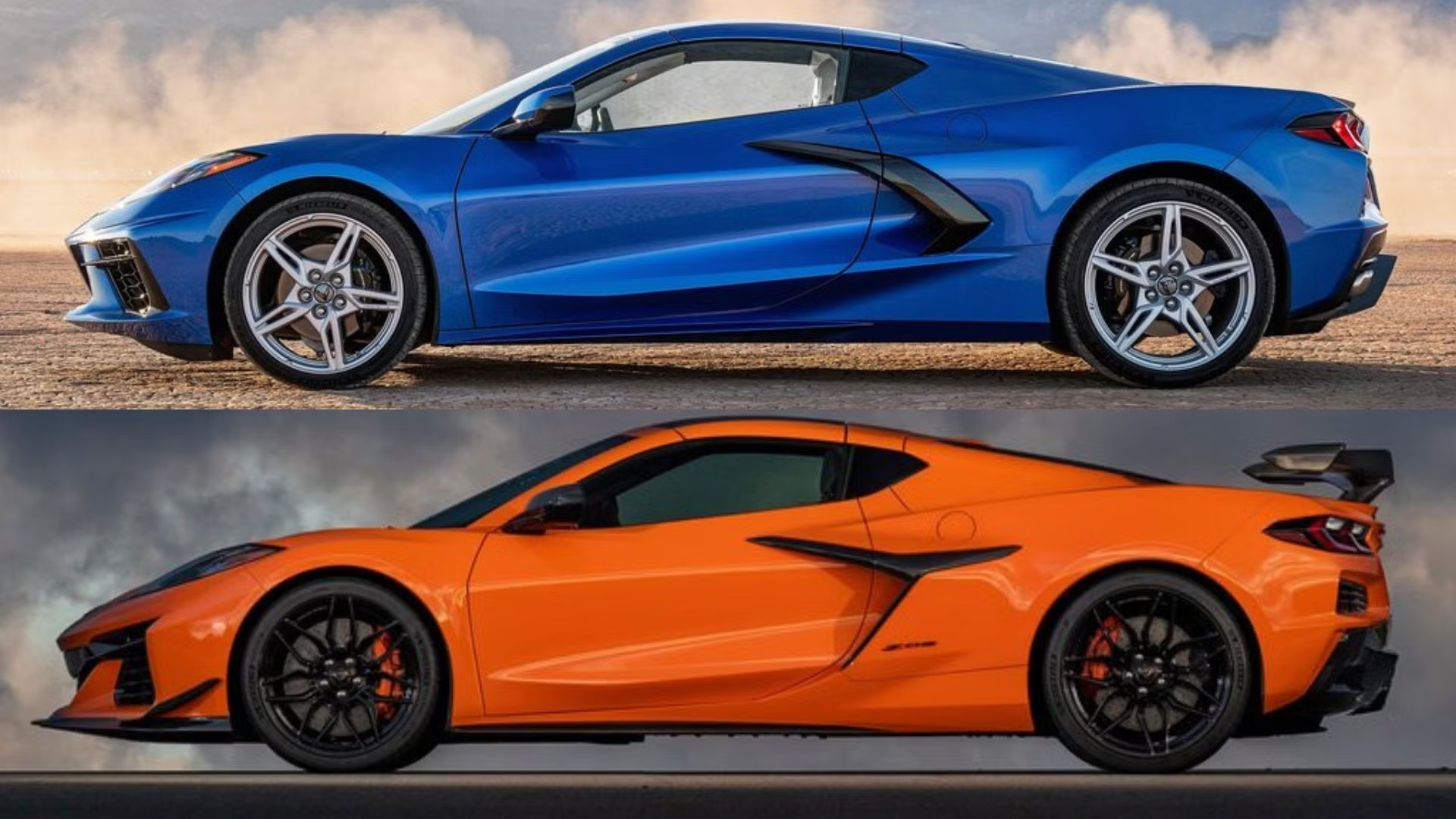Buying a car should be exciting—not a confusing maze of hidden charges, unexpected add-ons, and fine print. Unfortunately, for many buyers, what starts as an affordable deal quickly balloons into a far more expensive reality once dealer markups, documentation fees, and surprise accessories are tacked on.
The truth is, hidden fees are baked into the traditional dealership model, and many shoppers end up paying far more than the sticker price.
But not all car-buying experiences are built that way. Some automakers and platforms are pushing back against the old-school sales tactics by offering upfront, transparent pricing with no surprise costs. Whether it’s through direct-to-consumer sales models or no-haggle dealerships, these brands aim to give you exactly what you’re paying for—nothing more, nothing less.
5 Cars With No Hidden Fees
In this article, we’ve rounded up five cars that are sold with no hidden fees, providing a smoother, more honest buying experience. If you’re tired of the dealership games and just want to know the real price from the start, these are the vehicles worth considering.
1. Tesla Model 3
Sold directly by Tesla, the Model 3 comes with fixed pricing and no dealership markups. All fees—like destination and order fees—are clearly listed during checkout, with no surprise add-ons.
During our testing of the rear-wheel-drive Long Range variant, it accelerated from 0 to 60 mph in a brisk 4.6 seconds. We anticipate that the dual-motor, all-wheel-drive Long Range version will be even quicker. The 2024 Performance trim, which boasts more power than the pre-facelift model, clocked a 0-to-60 time of 2.8 seconds in our tests.
Tesla offers the Model 3 in three distinct trims, each delivering a unique estimated driving range. The rear-wheel-drive Long Range version is estimated to go 363 miles on a full charge, while the all-wheel-drive Long Range variant has an estimated range of 346 miles.
The Model 3 Performance trim prioritizes power over range, but still provides an estimated 296 miles per charge. In our real-world highway test conducted at 75 mph, the rear-wheel-drive Long Range model achieved 310 miles, while the Performance version reached 260 miles.
For charging, the Model 3 supports multiple methods: Tesla’s proprietary Supercharger fast-charging network, adapters for DC public charging stations, 240-volt and 120-volt household outlets, and a dedicated home-charging station.
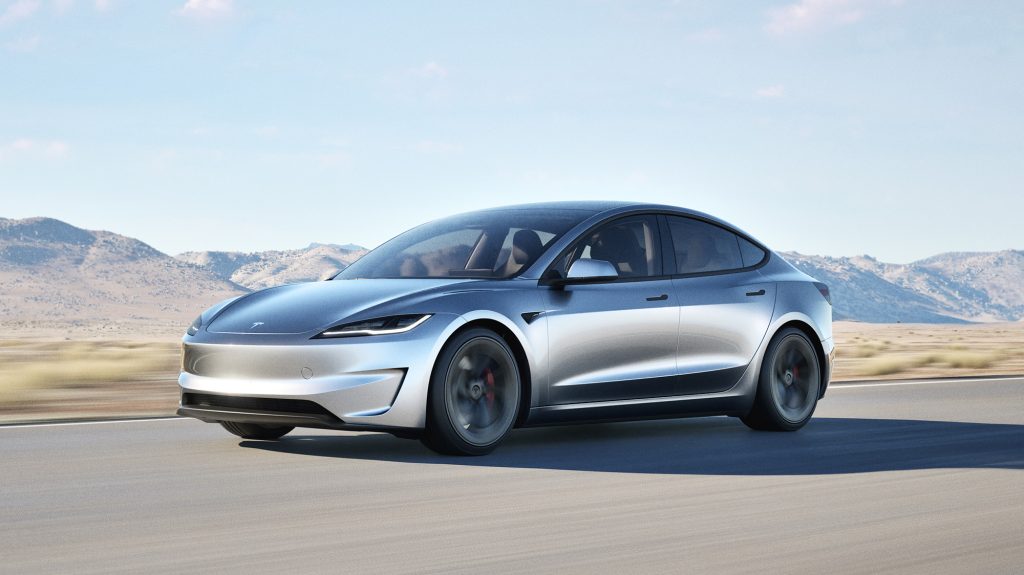
According to EPA estimates, the Model 3 variants deliver between 113 MPGe and 138 MPGe. In our 75-mph highway fuel-economy test, the Long Range RWD version returned 128 MPGe, while the Performance model achieved 91 MPGe.
All Model 3s are equipped with aluminum wheels covered by plastic aerodynamic hubcaps. Curious about the real-world impact of these hubcaps, we tested the car with and without them and were “surprised to find that they helped more than expected.”
The Tesla Model 3’s interior is truly unique compared to any other non-Tesla vehicle on the road. The cabin is extremely minimalist, with nearly all functions managed through a large central touchscreen mounted on the dashboard.
The steering wheel features buttons that operate controls such as the side-view mirrors, steering column adjustments, and even the turn signals—though we would have preferred more traditional controls in those areas.
The cabin feels open and spacious, thanks to the car’s low, flat floor. Front seats are both supportive and comfortable, but the rear seats are set low and feel cramped, making them uncomfortable for adults over extended periods.
The rear 60/40 split-folding seats are easy to collapse, substantially increasing the usable cargo space. With the seats down, the trunk can accommodate up to 15 carry-on suitcases. Additionally, the cabin offers ample storage in the form of bins and cubbies throughout.
Also Read: Top 10 Worst and 10 Best Trucks for Towing
2. Rivian R1T
Rivian’s all-electric pickup is sold directly through the company’s website. Pricing is transparent, with clear disclosures on delivery and prep fees. There are no dealer markups or upselling tactics.
The 2025 R1T stands out with impressively quick acceleration, clever storage solutions, a quiet and spacious interior, and bold styling. However, it still lacks Apple CarPlay and Android Auto, a drawback for many buyers.
Major additions for 2025 include new Tri Max and Quad Max motor configurations, the upscale Ascend trim, and a refreshed infotainment system that now supports apps like Spotify. Although part of the first R1T generation launched in 2022, these updates dramatically elevate its capabilities.
Despite its midsize-truck footprint, the R1T has grown more versatile with under-the-hood enhancements like improved software, updated battery packs, and faster processors.
Rivian’s Tri Max delivers 850 horsepower while the Quad Max boasts 1,025 horsepower, catering to those who crave speed. For range-focused drivers, the R1T can reach up to 420 miles on a charge. Off-roaders will value the Ascend trim’s enhanced terrain modes, and the R1T’s towing capacity, ranging from 7,700 to 11,000 pounds, makes it a practical hauler.
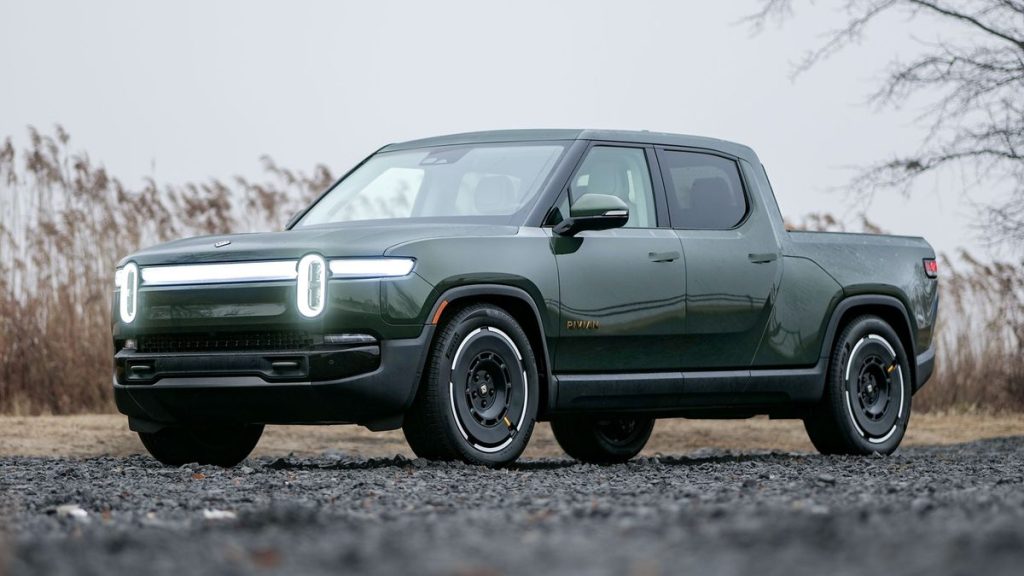
The R1T Dual Standard trim offers an EPA-estimated 258 miles of range. Based on Recurrent’s data, which analyzed 15,000 EVs, electric cars lose about 1–2% of battery range per year, meaning this model may offer around 219 miles after eight years.
Charging is facilitated through the SAE Combo port, compatible with Level 1, Level 2, and DC fast charging. A full charge at home using a 240V outlet takes approximately 9.5 hours. EV owners are advised to keep their batteries between 30% and 80% to prolong battery health. Compatibility with Tesla’s NACS charging network is expected in the future.
On the cost front, driving the R1T in North Dakota is estimated at $92 per month compared to $212 for the average truck. However, EV ownership makes the most sense when you have reliable access to a 240V charger at home or work.
Without that, relying on public charging can be slow and inconsistent—particularly outside the Tesla Supercharger network. Installing a home charger can cost anywhere from several hundred to $1,600 or more, depending on your electrical system’s readiness.
Rivian’s latest changes to the R1T include new battery and motor combinations and a more luxurious Ascend trim, available exclusively with the Tri Max and upcoming Quad Max setups.
The upgraded infotainment system now features Connect+ with access to Apple Music and YouTube, although it still lacks full smartphone integration—”Apple CarPlay and Android Auto still aren’t available.”
Additional improvements include revised cameras, sensors, and advanced driver assistance systems (ADAS). A retuned air suspension system offers improved ride comfort and handling, and updates to the vehicle’s electrical architecture enhance its performance and future readiness
3. Lucid Air
Lucid sells its luxury electric sedan directly to consumers. The buying process is streamlined, and all costs—including shipping and documentation—are shown upfront on the site.
Stationary traffic usually doesn’t offer much to marvel at—especially in a city like New York. But when you’re stuck downtown in Manhattan behind the wheel of a Lucid Air, all you have to do is glance upward.
The Air’s dramatic windscreen stretches seamlessly into the roof, giving you a panoramic view of the skyline and sky, transforming a mundane moment into an opportunity for sightseeing from a truly unique perspective.
The Lucid Air offers more than just a new view of your surroundings—it brings a new perspective to electric luxury itself. Lucid, the automaker behind the Air, is taking a bold and distinctive approach, aiming for the very top of the premium EV market.
These cars aren’t merely positioned above Tesla—they’re also keeping pace with established luxury giants like Bentley, Mercedes-Benz, and Audi.
Lucid began in 2007, initially focusing on battery technology and electric drive units. But by the middle of the 2010s, the company shifted gears to become a full-fledged automaker. The Air is its first production vehicle, and it’s clear that Lucid is making a statement.

The Lucid Air makes a remarkable debut. It’s incredibly efficient, exhilarating to drive, and luxurious enough to make you eager for what the brand will do next. The model tested receives a 9 out of 10 rating.
It boasts incredible performance, world-class efficiency, and a refined, comfortable ride. However, the car isn’t without drawbacks—it can feel heavy on the road, the large glass roof may not be ideal for all climates, and at this time, it’s not available in the UK.
Visually, the Air stands out in a crowded field. It’s sleek and futuristic, with an aerodynamic, understated design that avoids being loud or flashy. At just under five metres long—slightly larger than a BMW 5 Series—it has striking proportions and a clean aesthetic that should age gracefully. The car sits lower than most EVs, giving it a sporty posture while still maintaining elegance.
A large part of what makes the Air so innovative lies in its technology, much of which is designed and developed in-house by Lucid. Built on the company’s proprietary skateboard EV platform, the Air benefits from a layout that maximizes interior space.
The compact dual electric motors are also Lucid’s own design and cleverly integrate the transmission, inverter, and differential within the motor casing itself. This engineering not only saves space but also boosts performance.
The numbers back up the Air’s cutting-edge status. The dual motors deliver a combined 808bhp and 885lb ft of torque. Despite a substantial kerb weight of 2,360kg due to its all-aluminium construction, the Air Grand Touring can accelerate from 0 to 60mph in just 3.0 seconds.
For those craving even more speed, Lucid offers a Performance variant boasting a staggering 1,036bhp and a 0-60mph time of only 2.6 seconds.
But performance isn’t the Air’s only focus. Efficiency is at the core of its identity—something former CEO Peter Rawlinson emphasized. The in-house 112kWh battery is a key component, offering an EPA-rated range of up to 516 miles, depending on the model.
With its 300kW peak charging speed, the Air can add 300 miles of range in as little as 21 minutes when connected to a 350kW DC fast charger—making it one of the fastest-charging EVs on the market.
Lucid has paid obsessive attention to every aspect of efficiency, from battery chemistry to aerodynamics. According to lead designer Derek Jenkins, this included “reducing and minimising absolutely everything.” Even the headlights are engineered with efficiency in mind—they’re only 27mm tall, making them the slimmest in the industry.
The Air also rides approximately 4cm lower than a typical saloon, an achievement made possible by the compactness of its electric drivetrain. All this attention to detail results in an astonishing drag coefficient of just 0.2—a truly standout figure in the world of electric vehicles.
4. Hyundai IONIQ 5
This EV can be bought through Hyundai’s Evolve+ subscription or transparent pricing dealerships. Evolve+ bundles insurance, maintenance, and more into one clear monthly fee, avoiding hidden costs.
At first glance, you might mistake the Hyundai Ioniq 5 for a family hatchback if you’ve only seen it in photos. However, the reality is that this is actually a large electric SUV. Measuring 4.6 meters in length and 1.6 meters in height, the Ioniq 5 is nearly as big as the Audi Q5.
The distance between its front and rear axles stretches to three meters, which is the same as that of the Audi A8 limousine, providing passengers with a remarkable amount of interior space.
Hyundai offers plenty of variety within the Ioniq 5 range, allowing you to choose between two different battery sizes (which were increased in a recent update), rear-wheel or four-wheel drive configurations, and five trim levels. While it isn’t the most affordable option, the Ioniq 5 promises a substantial level of standard equipment, a solid range between charges, and a quick maximum charging rate.
While its striking looks are undeniable, the question remains: is the Ioniq 5 a good car in more objective terms? How does it compare to rivals like the Kia EV6, Renault Scenic, Skoda Elroq, and Tesla Model Y? Read on to find out how the Hyundai Ioniq 5 stacks up against the best electric SUVs available today.
The Hyundai Ioniq 5 stands out not just for its looks, but also for its impressive range, comfortable cruising experience, and spacious, practical interior. The best-value option is the rear-wheel-drive model with the smaller battery (RWD 170) in Premium trim, which undercuts the closely related Genesis GV60 and Kia EV6 in price.
The Ioniq 5 offers plenty of performance, rapid charging speeds, and an exceptionally spacious interior. However, it isn’t as quiet as the Genesis GV60 on the motorway, and it doesn’t handle as sharply as the Kia EV6. Additionally, the interior quality could be improved.
Also Read: 11 Foreign Car Brands Building Their Best Vehicles in America
When it comes to driving, the Hyundai Ioniq 5 offers a range of options. The entry-level model, the RWD 170, is our favorite. It features a 60kWh battery (up from the 54kWh of earlier versions) and a 168bhp motor driving the rear wheels. This setup allows the car to reach 0-62mph in 8.5 seconds.
Stepping up to the RWD 228 variant, which boasts a larger 80kWh battery (up from 74kWh) and a 225bhp motor, you get a quicker 0-62mph time of 7.5 seconds. Although it’s livelier than the base model, unless you require the extra range, the added cost might not be justified.
The top-tier model is the AWD 325, which retains the 80kWh battery but adds a second motor on the front axle for four-wheel drive and a total output of 321bhp. This version accelerates from 0-62mph in just 5.3 seconds, which is considerably quicker than any Renault Scenic or Skoda Elroq. Its performance is comparable to that of the dual-motor Kia EV6.
The Ioniq 5’s range varies depending on the version. Official estimates suggest up to 273 miles for the RWD 170, 354 miles for the RWD 228, and 311 miles for the AWD 325.
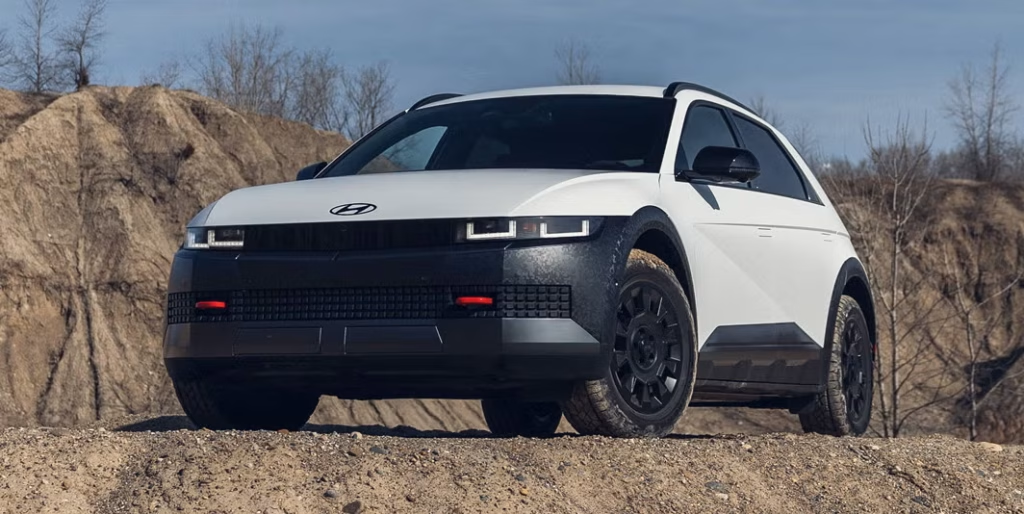
However, in real-world conditions, you’ll likely get fewer miles than those numbers suggest. The Kia EV6 RWD can cover up to 361 miles, while the Scenic Long Range has an even greater range of 379 miles.
For those interested in a performance-focused variant, Hyundai also offers an “electric hot hatch” version. To learn more about this model, check out our Hyundai Ioniq 5 N review.
Regarding ride comfort, the Ioniq 5 features a soft suspension that generally offers a comfortable ride. On 19-inch alloy wheels, the suspension smooths out most bumps quite well at higher speeds—especially by electric SUV standards.
However, at lower speeds, the car does thump more noticeably over potholes compared to the Genesis GV60 and Kia EV6. The 20-inch alloys fitted to higher-spec models exacerbate this effect.
Compared to the GV60, which has tighter body control and handles larger bumps more comfortably, the Ioniq 5 is still a much more pleasant ride than the jittery Tesla Model Y and feels more stable than the Nissan Ariya.
In terms of handling, the Ioniq 5 doesn’t match the nimbleness of the GV60 or the EV6. Its relatively soft suspension results in a somewhat loose feel when driving outside the city, with noticeable lean during quick cornering and a slightly hesitant response to sudden directional changes.
Nevertheless, it always maintains good grip, and the steering is accurate enough to allow for confident driving at all speeds. The AWD versions, with their additional traction, feel more stable, particularly when accelerating hard out of corners, even in wet conditions.
While the Ioniq 5 benefits from the inherent refinement of an electric SUV, it still has a few noise-related issues. If you opt for the 20-inch wheels, you’ll notice an increase in road noise. However, with the standard 19-inch wheels on the Advance and Premium trims, the road and wind noise are minimal, with only occasional suspension noises disturbing the tranquility.
If silent cruising is a priority, the Genesis GV60 may be a better option, thanks to its foam-filled tires and optional noise-canceling technology. The GV60 is notably quieter on highways, as is the Audi Q4 e-tron, which excels in creating a hushed environment.
5. Polestar 2
The Polestar 2, an all-electric performance sedan, is sold through Polestar’s direct-to-consumer model. Buyers can configure and order the car online with transparent pricing and minimal dealership involvement.
Fees like delivery and documentation are clearly shown during the purchase process, with no surprise markups or hidden add-ons.
The Polestar 2 is a fully-fledged production vehicle that aims to solidify Polestar’s position as a major player in the electric vehicle (EV) market. Its primary target? The Tesla Model 3, the biggest competitor in the segment.
Originally, Polestar was Volvo’s performance division, known for its racing endeavors, but it has since evolved into a separate entity, partially owned by Volvo and its Chinese parent company, Geely. The company manufactures its vehicles in China, with plans to sell them globally, combining Chinese ambition with Swedish premium expertise.
Polestar’s first self-developed vehicle was the stunning, limited-edition £140,000 Polestar 1, a plug-in hybrid that generated significant attention. However, the company made a more serious entry into the market with the launch of the Polestar 2 in 2019.
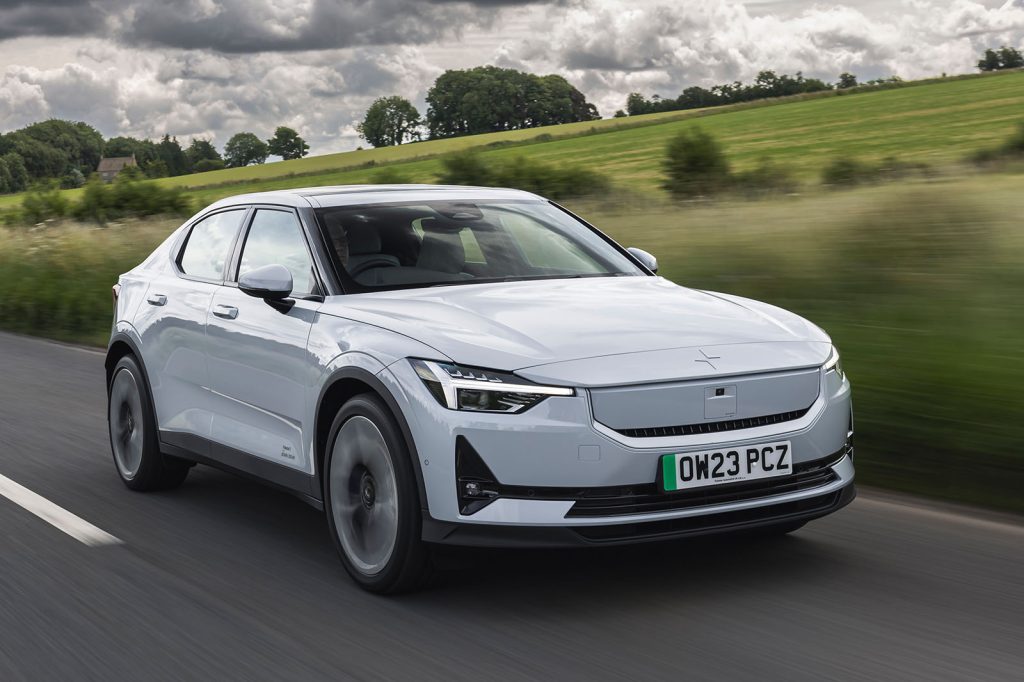
Fast forward to today, and the Polestar 2 has proven to be a success, surpassing sales expectations and developing a stronger sense of identity within the market.
As a result, the 2023 “refresh” (though it’s more than just a facelift) focuses on refinement rather than major changes. One significant improvement is the increase in range, which rises from 341 miles to 406 miles, making it a more capable EV in terms of distance.
The base model, the Standard Range Single Motor, comes with a 69kWh battery capable of achieving up to 339 miles of range (up from 297 miles), while the motor now generates 268bhp (up from 228bhp).
Next, the Long Range Single Motor features an 82kWh battery, which allows it to reach the 406-mile range milestone, and its power output increases to 295bhp.
For those seeking even more performance, the top-tier Long Range Dual Motor comes equipped with electric motors on both the front and rear axles, providing up to 368 miles of range. This version delivers 416bhp split evenly between the front and rear, making it quick, despite its weight of 2.1 tonnes.
Finally, there’s the Long Range Dual Motor Performance Pack – a £5,000 upgrade that boosts power to 469bhp. This version reduces the 0-60mph time to a mere four seconds and includes larger wheels, manually adjustable Öhlins dampers, Brembo brakes, and distinctive gold accents on the calipers, dust caps, and seat belts.
The Polestar 2 makes the most of its height, not only giving drivers a more commanding view of the road compared to a conventional saloon, but also providing ample space for the water-cooled battery pack, which is located beneath the cabin.
5 Cars That Cost More Than Expected
Here are 5 cars that often end up costing more than expected, either due to hidden fees, required add-ons, dealer markups, or high maintenance and ownership costs:
1. Jeep Wrangler
At first glance, the Jeep Wrangler seems like a rugged, relatively affordable off-roader. But once you start adding essential options—like hard tops, upgraded axles, or even basic infotainment features—the price skyrockets. Many dealerships also add “market adjustment” fees or force dealer-installed accessories that boost the total cost well beyond the sticker.
The Jeep Wrangler is a legendary off-road vehicle that has become synonymous with adventure and rugged terrain. Originally designed for military use during World War II, it has evolved into a civilian-friendly vehicle that retains its tough, no-nonsense character.
Known for its exceptional off-road capabilities, the Wrangler is built with high ground clearance, robust suspension, and standard four-wheel drive (4WD), making it capable of tackling challenging environments like rocky trails, mud, and steep inclines.
The vehicle is available with several engine options, including a 3.6-liter V6 engine, a 2.0-liter turbocharged 4-cylinder, a 3.0-liter EcoDiesel V6, and the Wrangler 4xe, a hybrid model combining a turbocharged engine with electric power.
These engines offer a range of horsepower and torque to suit different needs, with the 4xe hybrid providing a greener, more fuel-efficient option while still maintaining the Wrangler’s off-road capabilities. The Wrangler offers both automatic and manual transmission options, with the manual transmission being favored by off-road enthusiasts for its increased control on difficult terrains.
In terms of design, the Wrangler maintains its classic boxy shape, featuring iconic round headlights, a seven-slot grille, and removable doors and roof for an open-air driving experience. The interior is durable and practical, with water-resistant materials and modern technology like the Uconnect infotainment system, Apple CarPlay, Android Auto, and navigation.

While the Wrangler excels in off-road performance, it offers decent comfort and convenience features, though its ride on paved roads may not be as refined as other SUVs. The Wrangler also has a range of trim levels, from the base Sport model to the off-road-focused Rubicon and the hybrid 4xe.
Additionally, it offers excellent towing capacity, with a maximum towing capability of 3,500 pounds when properly equipped. Safety features like blind-spot monitoring and adaptive cruise control are available, though the Wrangler’s crash test ratings tend to be lower than some competitors due to its design.
Despite its impressive off-road prowess, the Wrangler does have some drawbacks, such as its relatively low fuel efficiency and less comfortable on-road handling compared to other vehicles in its class. Interior space may also feel a bit cramped, especially when compared to larger family-oriented SUVs.
However, the Wrangler remains a top choice for those seeking an off-road vehicle that can also be customized to suit a variety of lifestyles. Whether it’s for weekend adventures, off-road challenges, or just enjoying the open air, the Jeep Wrangler continues to stand out as a true icon in the SUV world.
2. Ford Bronco
High demand has made the Bronco notorious for dealer markups, especially on popular trims like the Wildtrak or Badlands. Buyers frequently report paying $5,000–$15,000 over MSRP, and long waitlists make negotiating nearly impossible. Even base models often come stripped-down, pushing buyers to select expensive option packages.
The four-cylinder Bronco with an automatic transmission is the most fuel-efficient variant, offering ratings of 20 mpg in the city and 22 mpg on the highway. When you upgrade to the V-6 version with the Sasquatch package, which includes aggressive, oversized tires, fuel economy takes a hit, dropping to 17 mpg in both city and highway driving.
We’ve tested Broncos equipped with both engines, using the automatic transmission on our 75-mph fuel-economy route. The four-cylinder achieved 22 mpg, while the V-6 earned 18 mpg. For more details about the Bronco’s fuel economy, you can visit the EPA’s website.
In terms of interior, comfort, and cargo, the Bronco offers open-air possibilities similar to those of the Wrangler, such as the ability to remove the doors and roof panels.
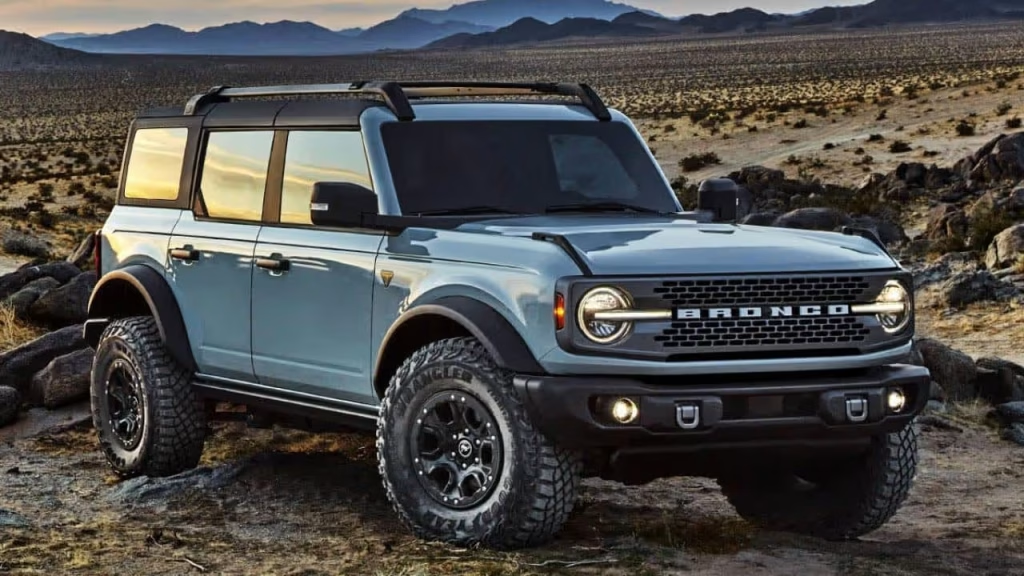
However, Ford’s interior boasts a few extra features that give it an edge over the Jeep. For instance, the Bronco comes with a built-in rack on top of its dashboard that allows you to mount smartphones and GoPros.
It also has frameless doors that are easy to remove, although the long side glass can sometimes catch the weatherstripping and lead to additional wind noise inside the cabin. The extended-wheelbase four-door models, however, provide enough space to store all four doors.
Since the exterior mirrors are mounted on the base of the windshield, they remain usable even when the doors are removed. If you’re looking to protect the cabin from the elements, you can opt for available rubberized flooring and marine-grade vinyl upholstery.
For a more premium experience, leather seating surfaces are available, though the extensive plastic used in the interior can give the upper trims a somewhat cheap appearance.
Even in the two-door Bronco, the back seat is spacious enough to accommodate two adults comfortably. In the four-door version, the rear seat can fit three passengers, and while it offers slightly more rear legroom, much of the added length is allocated to the cargo area, which is more than 50 percent larger than in the two-door model.
3. Toyota Land Cruiser (New Generation)
While Toyota marketed the new Land Cruiser as being more “affordable” than its predecessor, reality bites: the limited availability, high demand, and mandatory dealer packages can easily push it $10,000+ above expected pricing. It’s technically less expensive than the old model, but practically just as costly to buy.
Toyota Land Cruisers carry a certain aura, one forged through years of being the vehicle of choice for those in rugged parts of the world, where reliability is paramount, and other alternatives are hardly considered. After all, in remote areas, what’s more concerning: a little bit of scratchy plastic trim or the possibility of electrical issues?
However, the challenge for Toyota today, especially in Europe, lies in meeting the rising expectations of consumers. Since Land Rover reinvented the Defender, showing that off-road vehicles could offer car-like road manners without sacrificing off-road performance, and that these vehicles’ interiors could be both durable and a little luxurious, other manufacturers have had to step up their game.

The new fifth-generation, ‘J250’ Land Cruiser thus enters a different world than its predecessor, which, unbelievably, first went on sale in 2009. As a result, this new model is quite a departure from its predecessor.
Its design overhaul is just the tip of the iceberg, with major updates aimed at modernizing the LC experience while still preserving its core essence. Importantly, it retains body-on-frame construction
4. BMW 3 Series
The BMW 3 Series has an attractive base price—but it’s bare-bones. If you want common luxury features like adaptive cruise control, premium audio, or a more powerful engine, expect to add $10,000–$15,000 in options. Also, BMW’s maintenance and repair costs can sneak up on you fast after the warranty expires.
For decades, the BMW 3-series has been the benchmark in the entry-luxury sports sedan category, and it has remained at the top for good reason. Known for its sporty performance, the 2025 3-series continues to offer an exceptional balance of refinement and athleticism.
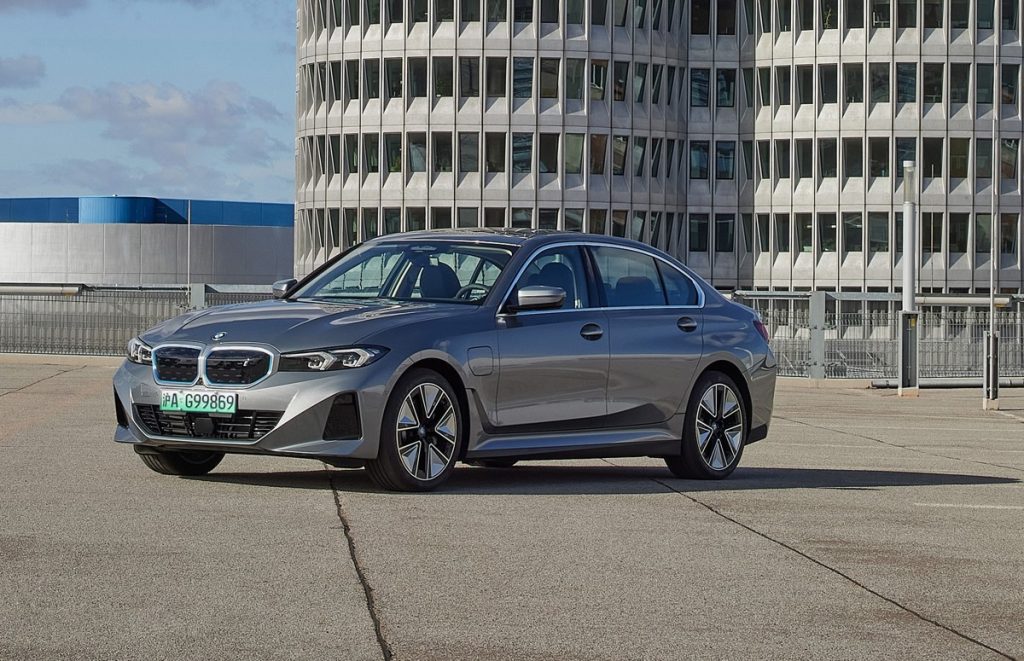
Whether you’re tackling errands or navigating twisty back roads, it provides an equally enjoyable driving experience. The base 330i model is equipped with a 255-horsepower turbocharged four-cylinder engine, while the more powerful M340i upgrades to a 386-hp turbocharged inline-six engine.
Both variants feature 48-volt hybrid systems and offer the choice of either rear-wheel or all-wheel drive. Inside, BMW has outfitted the 3-series with impressive technology, including a series of displays on the dashboard for infotainment and gauges, optional augmented-reality navigation, and all the essential driver-assistance features—though some of these may come as optional extras.
5. Chevrolet Corvette (C8)
The mid-engine C8 Corvette made headlines for offering supercar performance at a “bargain” price. In reality, the demand is insane, and dealer markups often push the price well beyond MSRP—sometimes by $20,000 or more. Adding performance packages and nicer interiors also ramps up the cost fast.
The C8’s capabilities far exceed my own driving skills, but I did push it hard on some mountain roads, and in that environment, the car is nothing short of spectacular. It feels tight, balanced, agile, and completely in control.

The LT2 engine delivers its 495-horsepower with a buttery smoothness, and the magnetic ride suspension is absolutely worth the $1,895 it adds to the price. The car grips the road as those shocks work their magnetic magic over bumps and dips, keeping the ride smooth and stable. The brakes felt powerful and progressive, while the steering was light yet highly communicative.
Although the car is packed with technology, I usually find that too much electronic intervention can spoil the driving experience, but with the C8, that was not the case at all. Despite the tech, the driving experience remained pure and direct, and the engineers at GM deserve a lot of credit for achieving this balance.
By now, all the major car magazines and online outlets have thoroughly covered the performance specs of the C8 Corvette, so I don’t have much to add in that regard beyond my personal driving impressions.

